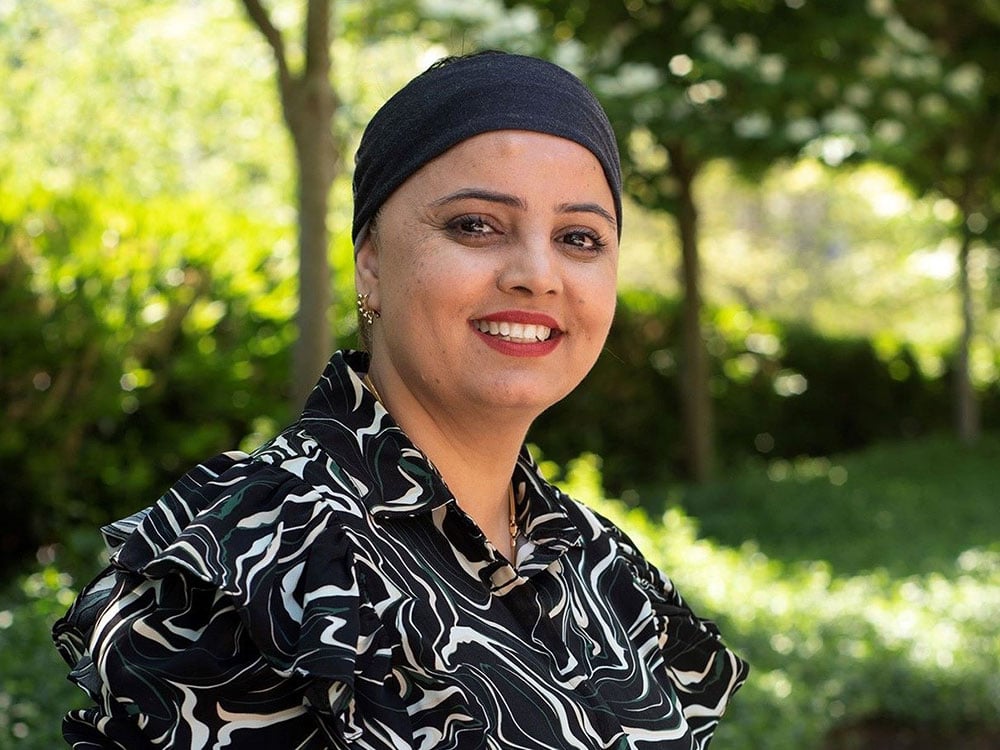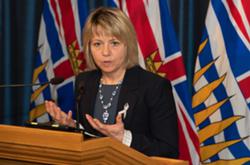As British Columbia takes steps toward inexpensive, widely available child care, many operators say they desperately need new workers. But barriers prevent immigrants and low-income people from getting and keeping those jobs, say advocates pushing for an overhaul of how child-care workers are supported in their careers.
Immigrants are “in the lowest tier when it comes to employment in the child-care sector, in terms of their wages, in terms of the working conditions,” said Anastasia Gaisenok, director of programs at Pacific Immigrant Resources Society. “They're a large proportion of the workforce, but they're really at the bottom.”
For this group, rising tuition costs, mandatory unpaid practicums and low wages make it difficult to enter and succeed in the child-care sector, according to workers and advocates interviewed by The Tyee.
They said five policy changes could smooth the path for aspiring caregivers who are low-income while helping to meet the need for daycare employees expected to rise in B.C.
1. Provide wider access to an existing wage top-up
Many immigrant caregivers find themselves denied access to a pay top-up available to others in the field.
In an effort to raise wages without impacting child-care fees, the BC NDP introduced a wage enhancement program in 2019. A $1 per hour increase was made available to certified early childhood educators working in licensed centres that were also participating in the Child Care Fee Reduction Initiative, which aims to have child-care fees down to $10 per day. Since 2019, the wage enhancement has gradually been increased to an extra $4 per hour on top of what educators were already making.
However, the wage enhancement is not simply a raise; the extra earnings are paid retroactively. While child-care workers participating in the program began making an extra $4 per hour in September 2021, they had to wait until March 2022 to receive their extra earnings.
Data from a Social Research and Demonstration Corp. and Early Childhood Educators of BC study shows a high level of take-up among facilities, with two thirds of respondents receiving the wage enhancement.
In workforce surveys from the past two years, workers who received the wage enhancement describe it as a “much needed” boost, with some saying that an extra $2 to $4 an hour means they no longer have to worry about paying bills at the end of the month.
But the wage enhancement is not available to everyone working in the sector.
Only child-care workers who have their early childhood educator certification and are working in licensed centres are eligible for the wage enhancement. Sheryl Burns, president of CUPE Local 1936, which represents community services and child-care workers in the Lower Mainland, said many workers face financial and language barriers when trying to get their certification, especially when English isn’t their first language.
Burns said it’s “demoralizing” for workers who can’t easily access higher education, or whose certifications gained in their home countries can’t be used here, to be left out of an initiative that is supposed to address the low wages in the sector.
“They're working alongside ECEs, pretty much doing the same work, and they're being paid $4 less per hour,” said Burns.
These concerns are backed up by recent surveys of the child-care workforce in B.C., which notes that the eligibility requirements of the wage enhancement have been a point of discussion in previous years as well. While some respondents felt that the wage enhancement recognized the time recipients spent in college, “some suggested the enhancement should be available to all members of the ECL workforce and not just those with an ECE designation.”
“These respondents were concerned that the sector would lose ECEAs [early childhood educator assistants] and RAs [responsible adults], who provided support to ECE staff, which would ultimately exacerbate staff shortages,” notes the report.
According to the survey, almost a quarter of child-care workers in licensed centres have either a responsible adult certificate, an ECE assistant certificate or no formal ECE education. None of these workers would be eligible for the wage enhancement.
Level of certification also varies by region, with only 50 per cent of educators in the Island Health region fully certified, compared to 70 per cent in the Vancouver Coastal Health region.
Survey respondents were asked whether they thought the wage enhancement was an incentive to complete training, but “most thought it was not and cited other reasons for ECEAs not completing training including the time and cost of training.”
Emily Gawlick, executive director of Early Childhood Educators of BC, said that overall, the wage enhancement is honouring the educational investment that certified ECEs have made in their careers. However, she acknowledges that some workers are getting left behind because of the nature of their work.
Child-care workers in "child-minding" programs are not eligible for the enhancement, regardless of their certifications. Child-minding programs are very similar to child-care programs, but they tend to be set up for limited periods in temporary locations rather than in dedicated child-care centres. Often, they cater to newcomer families, with parents accessing programs at the same location that their children are attending child care.
“They're really trying hard to do this really important work, but then they're some of the lowest paid people within our profession,” said Gawlick.
2. Smooth the path from ‘child minding’ to ‘child care’
The Pacific Immigrant Resources Society has been offering child-minding programs for decades. Opened in Strathcona in 1935, PIRS was created to support immigrant and refugee women who couldn’t attend programs to improve their English or upgrade their employable skills because of a lack of child care.
PIRS has operated child-minding services in a variety of locations across the Lower Mainland. When refugees arrive, PIRS finds out where they are settling and sets up free child care in the community, often in schools, churches or community centres.
In the process of offering child care to refugee and immigrant women, workers at PIRS realized there were a number of barriers these women face when trying to enter the child-care profession.
“The system is moving in a way that creates more fragmentation and inequalities, and [immigrant/refugee child-care workers] are not taken into account, even though they represent a big part of the sector,” said Gaisenok.
In 2018, they began the Pathways to Childcare Careers program, which offers training and work placements to the populations they serve.
Right now, the program offers occupation-specific language training and responsible adult training. To make the programs as accessible as possible, all expenses — from certification fees to any transit costs that participants might incur — are covered.
Valeria Mancilla worked with PIRS’s child-minding programs while she was studying for her ECE certification. She’d spend her mornings working in the child-minding program, her afternoons working at Collingwood Neighbourhood House, and her evenings in school. She said it was at the child-minding program that she developed her passion for working with children.
“That was where I felt that I was doing my best. With these kids, it was like, I'm making a difference in their lives, and the mothers’, because they experienced trauma as well,” she said. “So we were there to support them. Not only the kids, but also the mothers.”
Gaisenok said that in the future, they want to include ECEA and ECE certification, but finding funding has been a challenge.
“The vision of the program is that women are able to enter this training from an intermediate language level, get the support and move for all the different stages of certification, and support them through that process and make it work for them,” said Gaisenok.
3. Enhance financial support of practicum students in need
Early childhood educator programs require students to complete at least one practicum at a licensed child-care facility, often for four to six weeks. Many are unpaid, resulting in students working full time for weeks without compensation. Mancilla says unpaid practicums put a financial strain on many students, but are especially difficult for immigrant and refugee workers.
“Back then I was a single mom and I just, I couldn't. I was living paycheque to paycheque,” said Mancilla. “And that's the reality of many immigrants at least for the first 10 years when they come here.”
Mancilla remembers the guilt she felt every time she arrived at her neighbour’s house to find her son fast asleep on their couch. With only a half hour between her shifts at the local community centre and the evening classes she was taking to get her early childhood educator certificate, she frequently had no choice but to leave him with friends and neighbours for the evening.
Mancilla’s early childhood educator certification had been years in the making. After she and her young son arrived in Canada as refugees from Mexico in 2009, Mancilla began looking for a job, but without any Canadian experience she struggled to find more than 20 hours a week of work.
She spent most of her time volunteering as a child-minder with the Pacific Immigrant Resources Society as a way to do the work she loved and boost her resumé. Through everything, she processed the upheaval of being forced to move to a new country.
“We weren’t prepared for this,” said Mancilla. “The culture shock was massive for us.”
In order to get into the early childhood educator program, Mancilla had to pass a series of interviews. She spent six months preparing, practicing with the educators and assistants who worked at the child-care centre her son attended.
“I used to practice with them and they prepared me for the interviews. They supported me through that.”
After studying for over three years, it was finally time to graduate — but there was just one thing holding her back.
“It was time for me to do my practicum for one month and I just couldn't afford it,” recalled Mancilla.
Without completing her practicum, Mancilla wasn’t able to get her certification. She said her teachers were understanding of her situation, and they let her postpone her practicum until she was able to afford working for six weeks without pay. But that never became a reality for her.
She continued to work in child care despite not having her full certification, grateful to work for an employer that valued her work ethic and her experience. She has since made the move into organized labour, now working for CUPE Local 1936.
Mancilla met with then-Minister of State for Child Care Katrina Chen and Minister of Children and Family Development Katrine Conroy in 2019 to discuss unpaid practicums. She said there was a push after that meeting to encourage paid practicums in ECE programs, but many colleges and universities continue to treat unpaid practicums as a default.
4. Ease the burden of tuition
Not all immigrant and refugee child-care workers arrive in Canada without formal training. Some, like Amandeep Kaur, have degrees in education and years of experience in the classroom, but are unable to get their degrees certified to work in Canada.
Kaur has worked as a supervisor in the before and after school child-care programs at North Shore Neighbourhood House and the Vancouver Society of Children's Centres. After Kaur arrived in Canada, she completed a degree at the New York Institute of Technology’s Vancouver campus. She knew her foreign degrees would make finding a job in Vancouver challenging, so getting a degree at a local institution seemed like a good entry way into Canadian education.
Kaur didn’t want to change careers, having found her passion in education, and she hoped to update her skills with regards to using technology in the classroom setting.
But without Canadian work experience, finding a job in Canada was still a challenge. After months of searching, Kaur decided to take a job in child care. Since a lot of facilities operate on school grounds, she thought this might be a way to learn more about the teaching strategies and curriculum in Canadian schools, preparing her to one day work in the public education system.
“If, as an immigrant, you want to be around kids, this is somewhere you can start to teach,” explained Kaur.
Kaur said she still struggles to make ends meet. Though she earned more working on the North Shore than is typical of that role elsewhere in the Lower Mainland, she said her bi-weekly take home pay was around $1,200. Because she doesn’t have her ECE certification, Kaur isn’t eligible for the wage enhancement.
Going back to school would require Kaur to spend tens of thousands of dollars on tuition. Early childhood educator certification tuition for Canadian citizens and immigrants with permanent residency status can cost anywhere from $3,800 to $12,000, while international student tuition is often double or even quadruple that.
Research on the child-care workforce shows that the number of international students in early childhood educator programs has grown over the past decade. There were nearly five times as many international students in ECE programs in 2018 as there were in 2013.
As part of ChildCareBC, the provincial government, in partnership with Early Childhood Educators of BC, offers student and workforce bursaries to help with tuition costs in early childhood educator programs. The workforce bursary supports people already working in the child-care sector who want to upgrade their certifications.
Though the number of workforce bursaries awarded every year has been growing since the program’s debut in 2018, data from the Social Research and Demonstration Corp. and ECEBC report reveals only one workforce bursary was approved for every 10 student bursaries. The report’s authors note that the small number of workforce bursaries means the program’s impact on upgrading credentials in some regions, like Northern Health, has likely been small.
Like the wage enhancement, the workforce and student bursaries are paid retroactively, meaning students pay their tuition fees at the beginning of the semester and receive the bursary money once their courses are completed. The workforce survey quoted one respondent as saying that if people who want to upgrade their credentials don’t have the money to pay tuition, “you’re kind of out of luck.”
ECEBC executive director Gawlick said the organization anticipated that the workforce bursary system would have a smaller reach than the student bursaries. Since most ECE certificate programs run full time, a lot of workers struggle to take time off to go back to school. As for the retroactive bursary payments, “there’s a lot of back and forth around that,” said Gawlick, but ultimately it’s what was negotiated in their contract with the government.
“I get it. It's so hard for people to have that money upfront. So it would be interesting to see if it could progress, but that's just what we're stuck with right now,” said Gawlick.
Immigrants like Kaur, whose visas are sponsored by family members, are not eligible for these bursaries. Even if Kaur, who has two master's degrees, was planning to go back to school to get her ECE certification, her first step wouldn’t be applying to a nearby college — she’d have to retake high school level courses.
Kaur describes the many roadblocks to her career in education as frustrating.
“I'm doing everything backwards, rather than moving forward,” she said.
In her free time, Kaur volunteers with PIRS as a teacher and workshop leader. She helps women who are new to Canada and who want to pursue a career in child care understand the lay of the land: the differences between licensed and non-licensed centres, what certifications they need to start working, and the obstacles they’re likely to face.
“They never stop you from saying anything, that’s a big thing,” said Kaur. “All the participants in different workshops feel very free.”
In order to better assess how the child-care sector can expand while also including immigrant and refugee women, PIRS started a new program, Building a Childcare System that Works for Immigrant and Refugee Women. Now in its second year, the program brings together child-care workers, parents and caregivers to discuss their challenges.
Gabriela Cervantes, who oversees the program, said a lot of participants have university degrees but because their credentials aren’t recognized in Canada, many end up working with just their responsible adult certification.
“It's really hindering their career paths and their desires to enter the field fully,” said Cervantes.
5. Create a transparent wage grid
The feedback Cervantes hears from workers and caregivers informs her work on the Wage Grid Advisory Committee. She works alongside representatives from organizations like ECEBC and the Coalition of Child Care Advocates of BC to consult the government on the future of ECE compensation in B.C.
Advocates have long pushed for the implementation of a wage grid, which would set a provincial standard for early childhood educators’ compensation based on their credentials and years of experience in the sector. They argue a wage grid is essential in order to raise educator wages, correct for the inequities in the current system, and provide a predictable career pathway for educators.
Wage grids for the child-care sector are currently in place in Prince Edward Island, Manitoba and Quebec.
In June 2020, the Coalition of Child Care Advocates of BC and Early Childhood Educators of BC released a report assessing the potential for a wage grid for early childhood educators. In the report, they recommend a wage grid that sets the minimum hourly wage for workers with their ECE certificate at $26/hour, while those with their diploma would make a minimum of $29/hour. Educator assistants would make a minimum of $20/hour, but would not see their wages increase according to the wage grid, which advocates hope will encourage assistants to get their certificate or diploma. Workers with their responsible adult certification weren’t included in the proposed wage grid.
The 2021 bilateral Early Learning and Child Care Agreement between the BC NDP and the federal government, the first of its kind in the country, pledges to “support early childhood educators… through the development of a wage grid.”
However, details regarding the implementation of the wage grid have yet to be released. Instead, the BC NDP has opted to expand the wage enhancement to workers who spend less than half of their time in direct caring positions.
“I know that they’re still working on it,” said Gawlick when asked about the government’s progress on the wage grid.
When asked if the government has any plans to expand the eligibility requirements for the wage enhancement, Minister of State for Child Care Grace Lore said that there is still work to do in order to ensure that child-care workers are compensated in a way that reflects the importance of their work. She was not able to share a timeline for the wage grid.
“We know that the wage enhancement is an important piece, and we need to work with our partners to develop the wage grid and keep that work going,” said Lore.
Cervantes hopes that the future wage grid will better support the sector’s diversity.
“There are already lots of women in this country who want to do this work and are well suited for it and willing, and what is required is to just enable access to that employment for them,” said Cervantes. ![]()
Read more: Rights + Justice, Education, Labour + Industry
















Tyee Commenting Guidelines
Comments that violate guidelines risk being deleted, and violations may result in a temporary or permanent user ban. Maintain the spirit of good conversation to stay in the discussion and be patient with moderators. Comments are reviewed regularly but not in real time.
Do:
Do not: